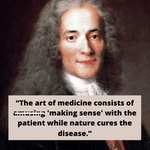The perspective that the body is an interconnected unit that displays regional interdependence is a valuable one. That different parts interact in different ways during different activities and influence ROM (range of movement) in other areas of the movement chain should seem a fairly easy link to make when looking at the whole body during different context dependent movements. We often eschew the value of the integrated system in favour of the isolated joint/muscle model.
Read more
Posts
One of the topics that regularly comes up in our courses is how relevant are more static/clinical tests to our everyday dynamic and function related movements. We have decided to address this in this blog.
We also have a special treat. A sneaky link to Cor-Kinetic founder Ben Cormack's new article in July's Sportex Medicine *Click Here*
Read more
I thought I would have a bit of a Jerry Maguire moment with my latest blog post!
Over the last few months I have certainly gone through a period of change with regards to how I understand the human body. Anybody who regularly reads my blog may have sensed that! I have begun to appreciate the brain as the command centre for all that we do, moving away from a more functional/biomechanical approach I had previously. This has been facilitated by some pioneering characters around me who I am thankful to for opening my eyes, even if it can feel sometimes that they don't want others to come along for the ride! I have certainly suffered my own bouts of cognitive dissonance along the way.
Read more
This is just a quick blog that was inspired by taking my son to the park yesterday. It is more anecdotal than scientific but something that I wanted to get across.
My son is developing so fast at the moment and it is amazing to watch. He is now 16 months and the two biggest areas I see his development in are movement and speech. It got me thinking about how we correct peoples movement problems and teach them to move better.
Read more
In the first part of this 3 part series we looked at patterns and how the brain recognizes patterns of information to then be able to recall or auto-associate a response from stored memory.
Read more
The brain and its role in movement and pain is taking a much larger role in what we do at Cor-kinetic. Rather than just seeing the body as feeding back to the brain on a mechanical level we are starting to understand the brains active role in everything we do.
Read more
So I have seen various variations on Gary Gray’s view that muscles are reactors. I think this is spot on. Muscles ARE reactors.
I think what Gary meant by this was that generally we see muscles as concentric force producers. Actually during movement we tend to need to decelerate motion by eccentric contraction first. Think walking first we flex to attenuate gravity, ground reaction forces, mass and momentum before creating force to move. So we are reacting to forces acting on the body before we create concentric force.
Read more
What a great question. Firstly I am not really sure that there is a definitive answer so let me say sorry in advance. The word functional seems to mean a lot of different things to a lot of different people so lets look at the Cor-Kinetic interpretation.
Read more
Now this post equally could have been hip pain, knee pain or foot pain when running. The available motion in the big toe or hallux will affect the operation of all of these body structures during integrated movement.
Read more
Things have been really busy with Cor-kinetic recently and I have not had a lot of time to blog. This post stems from a case I have been dealing with recently and I wanted to give an idea of our thought process at Cor-kinetic and how the symptom and cause of a problem are not always one and the same.
The patient in this case has been having Achilles problems on the left side and also lateral foot pain on the same foot. Interestingly the pain reduced the quicker he ran but more about that later.
Read more
Latest Articles
 If 9 out of 10 interventions are a load of rubbish, what the hell do I DO?August 4, 2022 - 3:29 pm
If 9 out of 10 interventions are a load of rubbish, what the hell do I DO?August 4, 2022 - 3:29 pm Why the advice to “rest” & “remain active” can both be a bit rubbish!December 21, 2021 - 2:38 pm
Why the advice to “rest” & “remain active” can both be a bit rubbish!December 21, 2021 - 2:38 pm Why I HATE discussions about treatment…….June 22, 2021 - 6:58 am
Why I HATE discussions about treatment…….June 22, 2021 - 6:58 am Evidence based practice – Do you love or loathe it?March 29, 2021 - 3:09 pm
Evidence based practice – Do you love or loathe it?March 29, 2021 - 3:09 pm- The myth of exercise prescriptions – It’s probably more trial and error than we care to admitOctober 15, 2020 - 11:43 am
 Education in rehab – WTF does it mean…..?October 1, 2020 - 12:15 pm
Education in rehab – WTF does it mean…..?October 1, 2020 - 12:15 pm
SIGN UP FOR UPDATES

